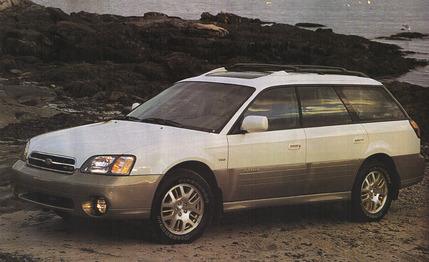
 First Drive Review
First Drive Review
Be careful what you ask for in life. You may get it. Take the Subaru Outback. When the current version of the four-cylinder wagon appeared in the summer of '95, U.S. marketers waged a campaign to have it categorized as a sport-utility vehicle. A few years later, Subaru produced a more traditional sport-ute, the compact Forester, and seemed to lighten up. Now we notice that the Japanese automaker has gone so far as to acquire a registered copyright declaring its Outback to be the "World's First Sport-Utility Wagon."
Okay, if Audi can call its wagons Avants after those front-drive Citroens from the Pleistocene Epoch, then awright awready, it's a sport-ute wagon. And now, finally, Subaru has acquired something even more important: a robust six-cylinder engine.
As a hauler of humans and their stuff, the five-passenger Outback is a capable performer. But that's not the reason to buy one. What drivers perceive to be special about Subarus, from the sporty Impreza to the businesslike Legacy sedan, is they all come with full-time four-wheel drive -- none of this part-time or "on demand" business -- and in the Outback's case, 7.3 inches of ground clearance, putting it up there within an inch of the off-road-capable Chevy Blazer and Nissan Xterra. Therefore, Subaru reasons, its wagon is a sport-ute in disguise, and as such, it has a clear edge in performance and fuel economy over most truck-based SUVs. Well, if somebody suggests a traverse of the Continental Divide in one without the benefit of asphalt beneath its tires, our advice is this: Don't go there.
Getting what you want can come with a price. What happens when the Outback is compared with better-handling station wagons, not leaning towers of sport-ute-dom? Last April, we inserted an Outback Limited into a four-wagon comparo, and it got hammered for possessing a hobbyhorse ride over dips, a punk engine, and too much body roll. It finished last.
And when it was originally compared with most sport-utes, its 2.2-liter, 135-hp four-banger felt puny. In '96, it got a 2.5-liter four putting down 155 horses, then an upgrade the next year to 165, but to little advantage. And when the Legacy grew in size and weight for 2000, the problem resurfaced -- that first 2.2-liter wagon tested in '95 went from 0 to 60 in 10.6 seconds, whereas the 165-hp 2.5-liter Outback tested last April was 0.1 second slower. The horizontally opposed "boxer" engine sits low and helps keep the center of gravity closer to the road surface, but it's exciting only when trying to merge onto a frantic, rush-hour freeway, particularly with the whole tribe in tow.
Comes now a new DOHC 3.0-liter, four-valve, six-cylinder engine. It increases power over the 2.5-liter four by 28 percent -- to 212 hp at 6000 rpm with 210 pound-feet of torque at 4400 rpm. Linked to an electronically controlled four-speed automatic transmission, the bigger engine will make its way into two models, the flagship Outback H6-3.0 VDC and an L.L. Bean Edition. The chief distinction between the two models is the equipment that has been added to keep the flagship VDC model from even thinking about putting you in the weeds during a bad driving moment. It has an all-wheel-drive system called Variable Torque Distribution (VDT), and a stability-control system dubbed Vehicle Dynamics Control (VDC), and a traction-control system. The VTD system uses a planetary center differential that splits front and rear torque 45/55. In the event of wheel slippage or a spin, the brakes can be applied individually to redirect torque or arrest the spin. Building a vehicle with four-wheel drive and a stability system is a tactic usually reserved for luxury cars.
The less-expensive L.L. Bean model comes with the standard Active All-Wheel-Drive system, which employs a hydraulically controlled clutch to apportion torque. The split is 90/10 front to rear most of the time, but rear torque is increased under acceleration or in case of wheelspin. This system includes a viscous limited-slip rear differential. The seats and fenders bear the mail-order giant's logo.